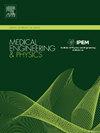Impact of marathon running on morphological variations in the knee joint based on statistical shape modelling
IF 1.7
4区 医学
Q3 ENGINEERING, BIOMEDICAL
引用次数: 0
Abstract
Objective
This study investigates the morphological variations influenced by marathon running by establishing a statistical shape model (SSM) of the knee joint for non-marathon-running Chinese women and comparing it with Chinese female marathon runners.
Approach
Magnetic resonance images of the knee joints of 8 Chinese female marathon runners and 48 female non-marathon controls were collected. A SSM of knee joint geometry was developed for the control group and assessed. Each model was individually fitted to extract the principal component weights, which were analysed using independent sample t-tests and Mann–Whitney U tests to identify significance. The differences of knee joint geometry between the two groups were compared by principal component to assess the impact of marathon running on knee joint morphology.
Main results
The SSM of the control group met evaluation standards. Marathon running maybe impacts the geometric structure of the knee joint significantly, notably manifesting as an outward bulge of the lateral femoral epicondyle, expansion of the trochlea and medial tibial, slight concavity of the tibial plateau, increased uniformity of the articular surfaces of the patella, and thickening of the posteroinferior region of the patella by comparisons.
Significance
Marathon running is one of the factors that influences morphological variations in the knee joint because of physiological adaptations to muscle training, with some areas even experiencing pathogenic tendencies of bone expansion. These findings will aid in the early diagnosis of marathon-related diseases, so as to provide an opportunity for early intervention to prevent such conditions. Besides, this can provide new theoretical support for sports medicine and formulate evidence-based exercise regimes.
基于统计形状建模的马拉松运动对膝关节形态变化的影响
目的通过建立中国女性非马拉松运动员膝关节形态统计模型(SSM),并与中国女性马拉松运动员进行比较,探讨马拉松运动对膝关节形态变化的影响。方法收集8名中国女性马拉松运动员和48名非马拉松对照组女性膝关节的磁共振图像。为对照组开发了膝关节几何图形SSM并进行了评估。每个模型都单独拟合以提取主成分权重,并使用独立样本t检验和Mann-Whitney U检验对其进行分析以确定显著性。采用主成分法比较两组膝关节几何形态的差异,评估马拉松运动对膝关节形态的影响。主要结果对照组SSM均达到评价标准。马拉松运动可能会显著影响膝关节的几何结构,主要表现为股骨外侧上髁向外突出,滑车和胫骨内侧扩张,胫骨平台轻微凹陷,髌骨关节面均匀性增加,髌骨后下区增厚。意义马拉松跑是影响膝关节形态变化的因素之一,因为膝关节对肌肉训练的生理适应,某些部位甚至出现骨扩张的致病倾向。这些发现将有助于马拉松相关疾病的早期诊断,从而为早期干预提供机会,以预防此类疾病。为运动医学提供新的理论支持,制定循证运动制度。
本文章由计算机程序翻译,如有差异,请以英文原文为准。
求助全文
约1分钟内获得全文
求助全文
来源期刊

Medical Engineering & Physics
工程技术-工程:生物医学
CiteScore
4.30
自引率
4.50%
发文量
172
审稿时长
3.0 months
期刊介绍:
Medical Engineering & Physics provides a forum for the publication of the latest developments in biomedical engineering, and reflects the essential multidisciplinary nature of the subject. The journal publishes in-depth critical reviews, scientific papers and technical notes. Our focus encompasses the application of the basic principles of physics and engineering to the development of medical devices and technology, with the ultimate aim of producing improvements in the quality of health care.Topics covered include biomechanics, biomaterials, mechanobiology, rehabilitation engineering, biomedical signal processing and medical device development. Medical Engineering & Physics aims to keep both engineers and clinicians abreast of the latest applications of technology to health care.
 求助内容:
求助内容: 应助结果提醒方式:
应助结果提醒方式:


